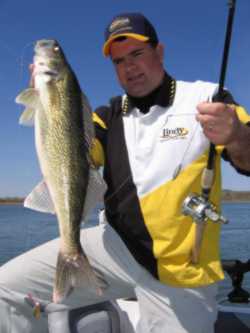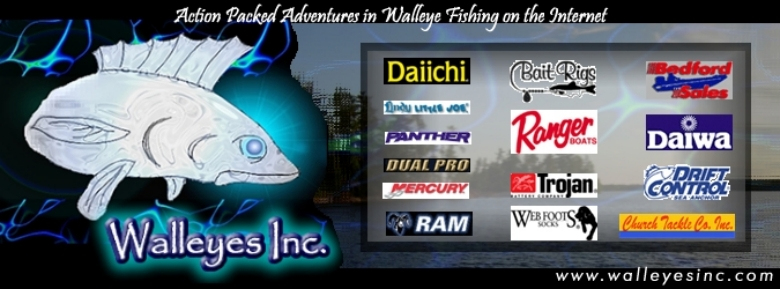The bottom bouncer is an incredibly effective and versatile
piece of equipment for walleye anglers. Over the past few
years, there seems to have been an emphasis on using the bottom
bouncer as more of a rigging tool. The bottom bouncer can
become a tool for efficiently presenting a live bait snell
or harness precisely through structure. With this application,
the presentation is often fairly vertical or close to a forty
five degree angle. Many anglers who prefer to use bouncers
in this method preach to never let out too much line or let
the bouncer drag. This is generally a slow and precise method
of presenting the rig through rock, following break lines
and generally staying on structure. There are plenty of other
ways to use the same bottom bouncer as this piece of wire
and lead offers a unique level of versatility.
 |
There are a handful of days each summer
while guiding where the fish should be where they were
the day before but are not. Frustrating and mentally exhausting
when everything is the same as the day before except the
fish are gone. The reality is that there are all kinds
of reasons after the fact but out on the water, there
are no rules. The fish could move anywhere for a variety
of reasons. They could be up the shoreline, deeper or
shallower, off relating to some entirely different structure.
The more frustrated I get as the clock ticks, the faster
I find myself fishing. Very frustrating when you make
a handful of decisions, tried what should work and still
can’t get back on top of fish. By now, the sun is
beating into my brain and my customers start second guessing
every decision I make. |
Unless you have some really good info, too much running at
this point can make the situation much worst as far as trying
a different part of the lake twenty miles away. I can guarantee
you that the fish that were in the area yesterday didn’t
all pack up and move that far. They usually move, but usually
you can see the part of the lake they moved to from where
you found them the day before. Sometimes, dropping water pulls
fish out of the bays and rising water pushes fish back into
bays further but you can bet that the fish are somewhere you
can visually see.
I don’t know how many days where I have been reincarnated
from the whipping post by dropping some heavy bottom bouncers
down and moving quickly through areas in an attempt to find
fish. There are a couple of factors that make this bottom
bouncer dragging so effective. First, a heavy enough bottom
bouncer keeps you just off the bottom regardless of speed
and easy to adjust with fluctuating depths. A heavy bottom
bouncer and harness is much more versatile than even a crankbait
behind lead core. You can burn over the top of a five foot
hump and fish all the way down to twenty feet by making minor
adjustments to your speed and amount of line out. You can
do the same with lead core but not nearly as easy. If you
have somebody in the boat that isn’t staying on top
of finding the bottom, the bottom bouncer is much more idiot
proof if you have enough line out and going fast enough where
the fish just hooks itself. Another factor is that the mile
and a half to two mile an hour speed that you can move these
bouncers through areas is a really nice speed for logging
sonar data and marking fish with your electronics. The final
selling point, speed is often an overlooked trigger. There
are so many times where we have a tendency to fish slower
when we think we have the location narrowed down. Common sense
tells us that sitting on top of fish makes more sense than
moving fast and spending a portion of our time out of the
zone. When we are fishing memories, we often have the sweet
spot dialed into our heads and we often have a tendency to
fish the spot slow, maximizing our time where we have a hook
down where we think there should be fish. Most days, this
strategy makes perfect sense and the fish make you look good.
There are those days however where for whatever reason, you
can fish slow and swear there isn’t a fish within a
mile. Kick up the speed and all of a sudden the same fish
that couldn’t muster the ambition to snip at a squirming
leech on a light, dainty snell will attack a harness sped
through the water.
The mistake many anglers make is not fishing heavy enough.
Use a bottom bouncer that finds the bottom. This is not finesse.
Also, use a heavy main line. Many anglers are using a heavy
duty Fireline for added sensitivity but there are also anglers
that swear by Berkley 10 pound XT for this application. You
want a tough and abrasion resistant line because when you
have a heavy bouncer crashing along way back behind the boat,
you will find snags and you need to power through them. The
snell needs to be heavy as well regardless of whether you
use a plain snell, spinner harness or bead. Plain snells work
well because with a heavier snell, you can kick up the speed
and not worry about your bait spinning so much that the line
twists into a mess. Many anglers are rigging half night crawlers
to spin on purpose. Ten to fourteen pound Berkley XL is perfect.
Even with the heavier mono snells, the half crawler can still
roll and spin seductively, especially if you use the tail
end of the crawler. Just adjust your speed and adjust your
crawler on the hook until you get a nice roll through the
water that really gets the soft flexible tail to flap.
This crash and burn tactic of using heavy bottom bouncers
and heavy line to find fish may seem crude to some walleye
anglers but the effectiveness can’t be denied. If the
fish aren’t hooking themselves, you aren’t going
fast enough. No feeding line or dropping the rod way back,
the fish are just bang, bang and on. Dragging the wire and
lead is effective and efficient when the chips are down. What
can really be surprising about using this method is exactly
where you stumble into fish again. Sometimes, fish just end
up on a part of a flat or shoreline and there is no visible
indicator that the fish should be where they are. This aggressive
use of bottom bouncers is a great way to find these fish.
Editors Note: The author, Jason Mitchell is a legendary guide
on North Dakota’s Devils Lake and designer of a premium
lineup of walleye rods called the Jason Mitchell Elite Series
Rods, www.jasonmitchellrods.com.
|

